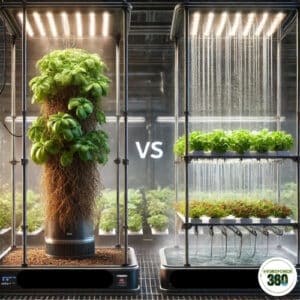All About Aeroponics vs Hydroponics
Table Of Content
If you’ve ever looked into growing plants without soil, one question probably came up sooner or later: aeroponics vs hydroponics — which one is actually better? The truth is, both of these methods are smart, modern, and capable of producing healthy plants in controlled environments. But that doesn’t mean they are the same. The real question is not about which method is universally superior. It’s about which one fits your space, your time, and your goals as a grower.

What Is Hydroponics Really About?
Hydroponics is the art of growing plants using water enriched with nutrients, eliminating the need for soil completely. The plant roots either stay submerged in a nutrient solution or rest in an inert growing medium like rockwool, clay pebbles, or coco coir. Everything the plant would normally get from soil— nutrition, water, and stability—is provided by the system you build.
Hydroponics can look very different depending on the setup. Some growers prefer Deep Water Culture, where the roots hang directly in the water. Others use systems like Nutrient Film Technique, where a shallow stream of nutrient solution constantly flows past the roots. Systems like ebb and flow or wick systems use other creative methods to deliver nutrients efficiently. What matters most is the principle behind it all — hydroponics feeds the plant directly, with precision and control.
What About Aeroponics?
Aeroponics takes the soilless concept one step further. In this method, plant roots are suspended freely in the air inside a sealed chamber. Instead of sitting in water, the roots are misted at regular intervals with a fine spray of nutrient solution. This allows the roots to absorb both nutrients and oxygen at extremely high levels, which can accelerate growth if everything is managed correctly.
Of course, aeroponics sounds futuristic for a reason. It’s cleaner, highly efficient, and uses even less water than hydroponics. But it’s also more sensitive to errors. If the misting system fails or clogs, roots can dry out very quickly. This is why many beginners choose to start with hydroponics first, which offers a little more room for learning and adjustment.
Differences Between Aeroponics and Hydroponics
While both systems eliminate soil, their core operations could not be more different. Hydroponics works by submerging roots partially or fully in nutrient solution. Aeroponics leaves the roots completely exposed to air and relies on fine mist for feeding. This changes everything about how the plants grow, how oxygen reaches the roots, and how much maintenance the system requires.
Hydroponic systems are usually easier to build and maintain. They tend to be quieter, less technical, and more forgiving when something goes wrong. Aeroponic systems, on the other hand, require precise misting timers, clean nozzles, and sometimes even backup power solutions to avoid root dehydration. Aeroponics rewards precision, while hydroponics rewards consistency.
Advantages of Hydroponics for Everyday Growers
Hydroponics is often the smarter choice for beginners or hobby growers for several reasons. First, setting up a basic hydroponic system can be done with simple materials. It does not require advanced pumps or misting equipment. Systems like Deep Water Culture or Kratky setups are perfect examples of how accessible hydroponics can be.
Additionally, hydroponics allows a variety of system designs to suit different spaces. Whether you are working with a kitchen counter or a full grow tent, hydroponics adapts well. The learning curve is reasonable, and maintenance usually involves checking nutrient levels and pH and keeping the reservoir clean.
What Makes Aeroponics So Appealing?
Aeroponics shines in commercial setups, research environments, and growers who love technology. The increased oxygen exposure to the roots can, in some cases, boost plant growth faster than hydroponic methods. Water usage is minimal because the mist delivers exactly what the roots need, without excess.
However, this efficiency comes with responsibility. Aeroponic systems must run perfectly to avoid problems. Mist systems can clog up. Timers must stay accurate. Power outages can lead to root damage fast. This is why aeroponics often attracts growers who enjoy the technical side of system management.
Cost Considerations Between Aeroponics and Hydroponics
Hydroponic systems are almost always cheaper to set up, especially for beginners. Basic materials like buckets, net pots, and air stones are affordable and easy to find. Aeroponics systems, by contrast, require high-pressure pumps, misting nozzles, timers, and sealed growing chambers. Even DIY aeroponics projects usually cost more than comparable hydroponic setups.
Maintenance costs also differ. Hydroponic systems require regular nutrient solution changes and cleaning, but aeroponics demands constant nozzle maintenance to prevent clogging.
Which System Grows Plants Faster?
In theory, aeroponics can grow plants faster because roots have maximum access to both oxygen and nutrients. But in practice, many growers find that hydroponics delivers excellent growth speed with less risk and less hassle.
Which One Should You Choose?
If you are just starting your journey in soilless growing, hydroponics is almost always the smart first step. It’s easier to build, more forgiving to manage, and perfectly capable of producing vibrant, healthy plants.
Aeroponics is an exciting option for those who want to take their growing to the next level. It requires technical precision but offers incredible efficiency and growth potential in the right hands.
In the end, the decision between aeroponics vs hydroponics isn’t about which system is universally better. It’s about what works best for your skills, your space, and your style of growth.
FAQs
What is the main difference between aeroponics and hydroponics?
The main difference is that hydroponics keeps roots in contact with nutrient-rich water, while aeroponics suspends roots in the air and feeds them with nutrient mist.
Is aeroponics better than hydroponics for beginners?
Not really. Aeroponics offers faster growth in some cases but is much more sensitive to errors. Hydroponics is beginner friendly.
Which system is cheaper to set up?
Hydroponics is almost always cheaper and easier to build at home compared to aeroponics.
Does aeroponics save more water than hydroponics?
Yes, aeroponics uses even less water because it delivers nutrients through a controlled mist, reducing waste.
Table Of Content
